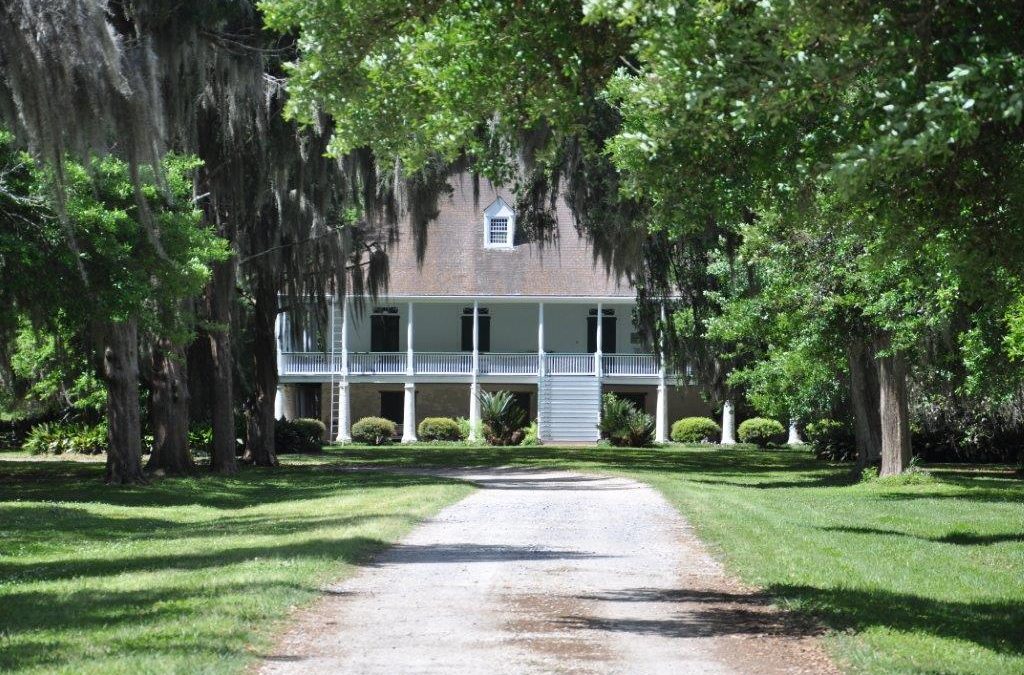
by admin | Apr 16, 2013 | Greater Baton Rouge
In all of our years visiting picturesque St. Francisville, we had never made it across the river to visit its sister city,
New Roads. When an advertised Historic House Tour caught my attention, our weekend plans were sealed and we loaded the car with toys for our two-hour drive from New Orleans.
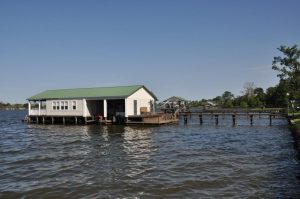 |
| Pier and boat house on False River |
We followed LA 1 and the Louisiana Scenic Bayou Byway to the southeastern edge of False River, an oxbow lake once part of the Mississippi River before it changed route and cut off the lake. The main road runs along a steep dropoff, creating a unique effect where the homes on our left were at eye level yet we were driving beside rooftops on our right. Graceful plantations with sprawling lawns dominated the road’s left side, and newer homes with lines of piers jutting out into the water stood to the right.
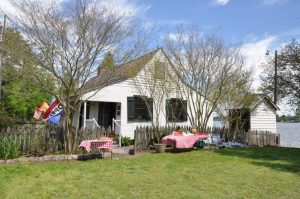 |
| Pointe Coupee Parish Museum and Tourist Center |
Colorful balloons bouncing in the wind beckoned us to stop at the Pointe Coupee Parish Museum and Tourist Center, where a table of coffee, homemade cookies and free gourds awaited our arrival. The kids darted through the small museum, not even bothering to look up before exiting out the back door to look for frogs in the sugar kettle out back. They were relatively contained within the fenced yard, so we managed to squeeze out a few minutes of conversation with the tour guides. Turns out the house itself was from nearby Parlange Plantation, and items in the museum documented life in 18th and early 19th century Louisiana. Listed on the National Register of Historic Places, the building, according to the National Park Service, is “a rare example of a log cabin type construction in a Creole type house.”
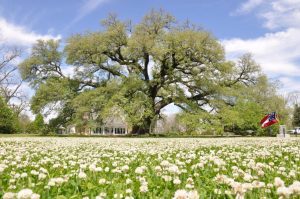 |
| Randall Oak |
From here, we followed the balloon trail, our marker for all the open houses on the tour. Down the road was the Randall Oak, a beauty of a live oak making its way to the top of the Live Oak Registry. Although a center split gives the impression of two separate trees grown together, the tree’s owner assured us it was only one massive oak. Poydras College once stood nearby this location, where Professor James Randall wrote the poem, “Maryland, My Maryland,” which is today Maryland’s official state song. While here, we peaked next door at Mon Reve’, a lovely French Creole home that unfortunately had dropped out of the historic homes tour.
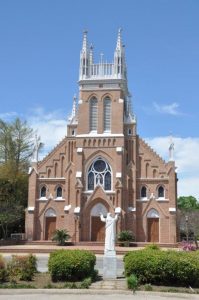 |
| St. Mary of False River |
Our map from the Visitor’s Center led us into downtown New Roads. As soon as we entered, we parked our car for a stroll along Main Street.We skirted in between buildings to access public docks where half a dozen people were out fishing for the day on False River. A few boats passed by as well, undoubtedly enjoying the warm sunshine and cool afternoon breeze. We took note of several interesting restaurants located in historic buildings, such as Ma Mama’s Kitchen, but we forewent a lengthy, sit-down lunch in favor of quick club sandwiches and grilled cheese at the local Cafe.
After eating, the kids exhausted some of their energy playing in the beautiful gardens surrounding St. Mary of False River Church, a Gothic-style church completed in 1907. A few blocks down, Pointe Coupee Parish Court House is another focal point of the town, resembling a medieval castle erected on Main Street.
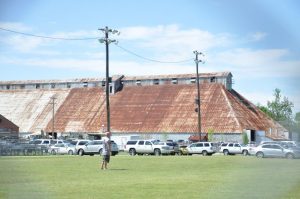 |
| Market at the Mill |
Back in the car, we visited more historic homes on the list, such as the LeJeune House, home to a family with 12 children–all of whom never married. The Samson House, also known as Pointe Coupee Bed and Breakfast, and the Pourciau House were another two landmarks on the tour. Our final stop in downtown was the Market at the Mill, a retired cottonseed oil mill that happened to be hosting its three-day, annual “shopping extravaganza” of antique and vintage items. From the look of the parking lot, it appeared to be a very popular destination.
The town and surrounding area is quite lovely, and we drove around a while longer just sightseeing while the kids snoozed in the backseat. For the route home, we detoured on LA78 toward Frisco and on to Livonia, searching for an Indian mound we had read about in the book New Roads and Old Rivers: Louisiana’s Historic Pointe Coupee Parish. Built between 700 AD and 1200 AD by the Coles Creek Culture, the mound is uniquely out of place next to a Dollar General Store. However, upon contacting the town, we learned that it was donated by the property owners to the town, and plans are in the works for highlighting its prominence in Louisiana’s history.
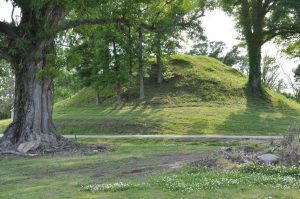 |
| Livonia Mound |
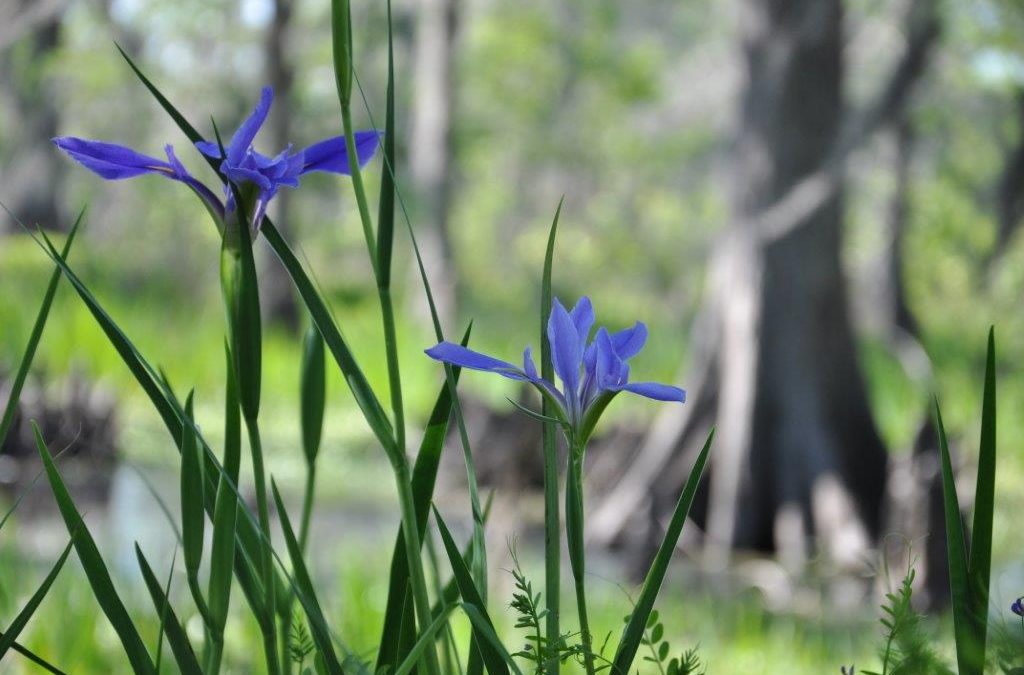
by admin | Apr 9, 2013 | Greater New Orleans, Most popular
We’ve been on a kick lately traveling to the end of all the roads in Louisiana–first in Plaquemines, then St. Bernard and now Jefferson via the Town of Jean Lafitte. It’s altogether quite a different drive than the other two, most notably because we didn’t seem to pass any refineries along the way–or at least any we could see.
 |
| Hope Haven |
The adventure began when we exited the Westbank Expressway in Marrero and turned on to Barataria Boulevard. Almost immediately, we were met with some of the most striking architecture in Jefferson Parish. Built in the 1920s and 30s, Hope Haven’s Spanish Colonial Revival-style buildings stand out amid this otherwise typical suburban area. From my Internet searches, it appears the impressive buildings house a school and a case management and family support center run by Catholic Charities, but they are grand enough to rival the Spanish missions found in Texas and California.
 |
| The water-filled, historic Town of Jean Lafitte |
Continuing south, we made a left on Leo Kerner Parkway and entered a long stretch of uninhabited highway. Both this route and Barataria Blvd. lead to Jean Lafitte National Historical Park and Preserve, one of our favorite spots to explore the swamps and a place I’ve written a lot about in the past. This weekend, however, we had a new destination, passing by the park’s entrance and ascending the high bridge over the Intracoastal Waterway. As the road descends, a pirate ship rocking on the high seas announces you’ve entered the historic town of Jean Lafitte.
We followed scenic Jean Lafitte Boulevard along Bayou Barataria, noting that the majority of the elevated houses here seem to be permanent homes to the town’s residents rather than secondary fishing camps. Our first stop was the new Lafitte’s Barataria Museum and Wetland Trace, which celebrated its grand opening on Saturday. A large tent out front indicated the celebration, and the kids were shouting “balloons!” before we left the car. While they ransacked the kids’ table, gathering up stickers, coloring books, pirate bandanas and tattoos, Paul and I eyed the free tastings of alligator-stuffed mushrooms and crab cakes. In hopes of relaxing and enjoying the live Cajun music, we set up our folding chairs in front of Bruce Daigrepont and his band, yet the kids had sat long enough in the car and were not remotely interested in relaxation.
.jpg) |
| Lafitte’s Barataria Museum |
So we herded them into the museum, where a half hour movie introduced us to the town’s history and that of its residents. Beautiful aerial shots showed the village surrounded by its lifeblood of water, swamp and marsh, and one resident drove the message home by saying he never knew there was solid land until he was taken to the French Quarter when he was 14. The town itself takes its name from the notorious pirate Jean Lafitte, who used the mysterious swamps to hide his smuggling operations. Today’s residents aren’t quite as scandalous, yet those we met were perhaps just as entertaining and lively.
The museum, although small, is packed with intriguing items from the area, from an entire display of the animals found here to a gun used by one of Lafitte’s pirates during the Battle of New Orleans. Although 2-year-old August buried his face when confronted with the talking alligator, the other children present got a kick out the reptile. Unfortunately, two among us didn’t have the patience for the oral history presentations, so we skipped that section to instead head out back to the Wetland Trace.
 |
| Alligator along the Wetland Trace |
Nearly a mile long, this boardwalk trail through the swamp caught our 5-year-old’s attention like nothing else that day. We spent an hour and half stalking snakes and lizards, pointing out alligators to others passing by and trying to determine what and where all that clicking noise was (our best guesses were baby birds in the rookery or click beetles taunting us from the trees). Although the lines were too long for us to join the swamp tour leaving the docks off the back of the boardwalk, the entire mission was still a success as we saw five snakes of varying sizes and colors, countless water turtles and one very close alligator. Plus, now we have something more to go back for next time.
 |
| Boat ready for a new paint job |
Back in the car, Charles begged to continue down the road as he wasn’t ready to go home yet, so we kept driving to see what else we could find. On our way to the museum, we had passed an old plantation, still standing but fighting a losing battle with the elements and weeds threatening to suck it back into the earth. Now, on our left, an old boat was lifted on barrels, preparing for an overhaul from its owner.
At the museum, we had learned that Lafitte is home to 11 cemeteries. Fleming Cemetery, notable for its white-washed tombs on top of an Indian mound, is privately owned and inaccessible to the public, yet can be seen from the water and is a highlight of area boat tours. Another, Lafitte Cemetery, is said to be the burial grounds of Pirate Jean Lafitte himself. This was our last photo op before the main road branched off into smaller outlets and essentially ended at a busy boat ramp bustling with fishermen.
 |
| Legend says this is the burial grounds of Pirate Jean Lafitte |







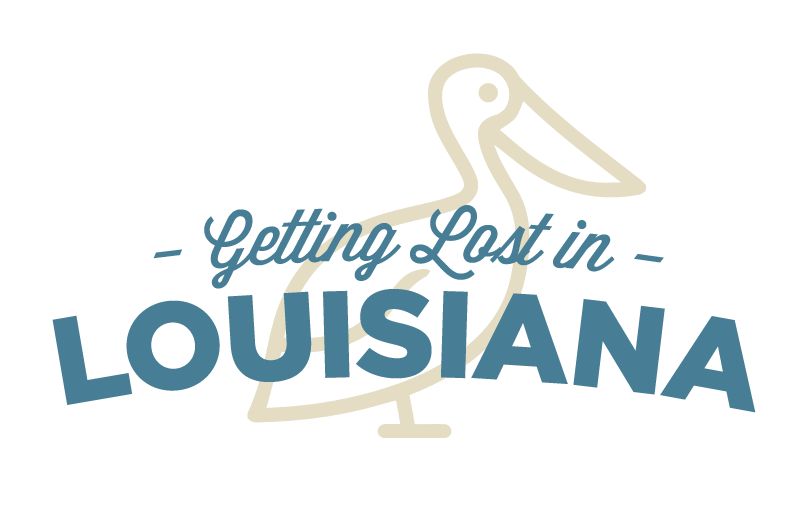

.jpg)